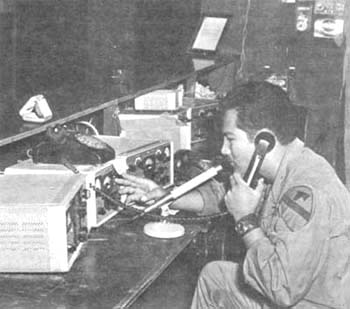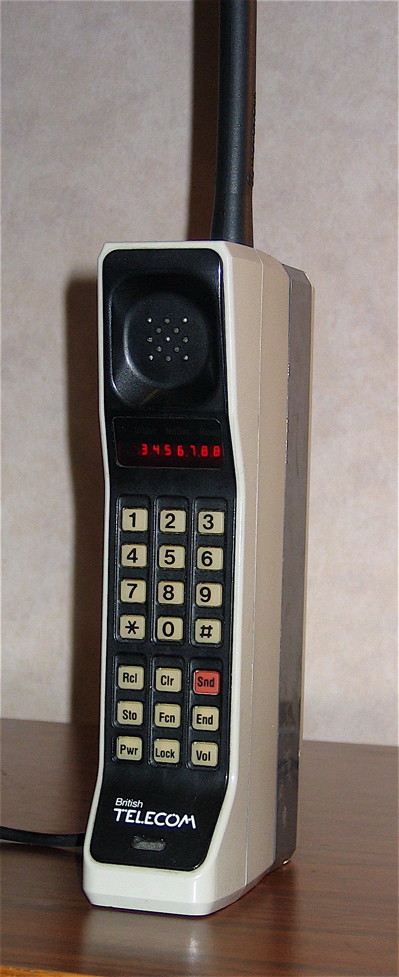|
Autopatch
An autopatch, sometimes called a phone patch, is a feature of an amateur radio (or other type of two-way radio) repeater or base station to access an outgoing telephone connection. Users with a transceiver capable of producing touch tones (DTMF signals) can make a telephone call, typically limited by settings in the autopatch module to be only to flat-rate numbers, such as local calls or toll-free numbers. Phonepatch vs. mobile telephony The fact of connecting a ham radio station to a telephone network exists from the beginning of the ham radio operators, even commercially, as the case of Carterfone (with lawsuits filed by the companies to which it was connected), but it was not possible to talk about mobile telephony until the arrival of the cellular network AMPS, initially using a car phone as the cellular terminal, and finally with the arrival of the DynaTAC, the first mobile phone "properly talking" (being able to hold the whole unit in the hand). The term ''phone patch'' ... [...More Info...] [...Related Items...] OR: [Wikipedia] [Google] [Baidu] |
Carterfone
The Carterfone is a device invented by Thomas Carter. It manually connects a two-way radio system to the telephone system, allowing someone on the radio to talk to someone on the phone. This makes it a direct predecessor to today's autopatch. Description The device was acoustically, but not electrically, connected to the public switched telephone network. It was electrically connected to the base station of the mobile radio system, and got its power from the base station. All electrical parts were encased in bakelite, an early plastic. When someone on a two-way radio wished to speak to someone on phone, or "landline" (e.g., "Central dispatch, patch me through to McGarrett"), the station operator at the base would dial the telephone number. When callers on the radio and on the telephone were both in contact with the base station operator, the handset of the operator's telephone was placed on a cradle built into the Carterfone device. A voice-operated switch in the Cart ... [...More Info...] [...Related Items...] OR: [Wikipedia] [Google] [Baidu] |
Popular Mechanics
''Popular Mechanics'' (sometimes PM or PopMech) is a magazine of popular science and technology, featuring automotive, home, outdoor, electronics, science, do-it-yourself, and technology topics. Military topics, aviation and transportation of all types, space, tools and gadgets are commonly featured. It was founded in 1902 by Henry Haven Windsor, who was the editor and—as owner of the Popular Mechanics Company—the publisher. For decades, the tagline of the monthly magazine was "Written so you can understand it." In 1958, PM was purchased by the Hearst Corporation, now Hearst Communications. In 2013, the US edition changed from twelve to ten issues per year, and in 2014 the tagline was changed to "How your world works." The magazine added a podcast in recent years, including regular features ''Most Useful Podcast Ever'' and ''How Your World Works''. History ''Popular Mechanics'' was founded in Chicago by Henry Haven Windsor, with the first issue dated January 11, 1902. ... [...More Info...] [...Related Items...] OR: [Wikipedia] [Google] [Baidu] |
Music On Hold
Music on hold (MOH) is the business practice of playing recorded music to fill the silence that would be heard by telephone callers who have been placed on hold. It is especially common in situations involving customer service. Music on hold is sometimes referred to as phone on hold, message on hold, on hold messaging, or hold music. Development Music on hold was created by Alfred Levy, an inventor, factory owner, and entrepreneur. In 1962, Levy discovered a problem with the phone lines at his factory: a loose wire was touching a metal girder on the building. This made the building a giant receiver, so that the audio broadcast signal from a radio station next door would transmit through the loose wire, and could be heard when calls were put on hold. Levy patented his work in 1966. While other advancements have come to change and enhance the technology, it was this initial patent creation that began the evolution for today's music on hold. Equipment and formats Most MOH systems ... [...More Info...] [...Related Items...] OR: [Wikipedia] [Google] [Baidu] |
United States
The United States of America (U.S.A. or USA), commonly known as the United States (U.S. or US) or America, is a country primarily located in North America. It consists of 50 states, a federal district, five major unincorporated territories, nine Minor Outlying Islands, and 326 Indian reservations. The United States is also in free association with three Pacific Island sovereign states: the Federated States of Micronesia, the Marshall Islands, and the Republic of Palau. It is the world's third-largest country by both land and total area. It shares land borders with Canada to its north and with Mexico to its south and has maritime borders with the Bahamas, Cuba, Russia, and other nations. With a population of over 333 million, it is the most populous country in the Americas and the third most populous in the world. The national capital of the United States is Washington, D.C. and its most populous city and principal financial center is New York City. Paleo-Americ ... [...More Info...] [...Related Items...] OR: [Wikipedia] [Google] [Baidu] |
Mobile Phone
A mobile phone, cellular phone, cell phone, cellphone, handphone, hand phone or pocket phone, sometimes shortened to simply mobile, cell, or just phone, is a portable telephone that can make and receive calls over a radio frequency link while the user is moving within a telephone service area. The radio frequency link establishes a connection to the switching systems of a mobile phone operator, which provides access to the public switched telephone network (PSTN). Modern mobile telephone services use a cellular network architecture and, therefore, mobile telephones are called ''cellular telephones'' or ''cell phones'' in North America. In addition to telephony, digital mobile phones ( 2G) support a variety of other services, such as text messaging, multimedia messagIng, email, Internet access, short-range wireless communications (infrared, Bluetooth), business applications, video games and digital photography. Mobile phones offering only those capabilities are known as fea ... [...More Info...] [...Related Items...] OR: [Wikipedia] [Google] [Baidu] |
DynaTAC
DynaTAC is a series of cellular telephones manufactured by Motorola, Inc. from 1983 to 1994. The Motorola DynaTAC 8000X commercial portable cellular phone received approval from the U.S. FCC on September 21, 1983. A full charge took roughly 10 hours, and it offered 30 minutes of talk time. It also offered an LED display for dialing or recall of one of 30 phone numbers. It was priced at $3,995 in 1984, its commercial release year, equivalent to $ in . DynaTAC was an abbreviation of "Dynamic Adaptive Total Area Coverage". Several models followed, starting in 1985 with the 8000s, and continuing with periodic updates of increasing frequency until 1993's Classic II. The DynaTAC was replaced in most roles by the much smaller Motorola MicroTAC when it was first introduced in 1989, and by the time of the Motorola StarTAC's release in 1996, it was obsolete. History The first cellular phone was the culmination of efforts begun at Bell Labs, which first proposed the idea of a cellula ... [...More Info...] [...Related Items...] OR: [Wikipedia] [Google] [Baidu] |
Car Phone
A car phone is a mobile radio telephone specifically designed for and fitted into an automobile. This service originated with the Bell System and was first used in St. Louis on June 17, 1946. Overview The original equipment weighed , and there were initially only 3 channels for all the users in the metropolitan area. Later, more licenses were added, bringing the total to 32 channels across 3 bands (See IMTS frequencies). This service was used at least into the 1980s in large portions of North America. On October 2, 1946, Motorola communications equipment carried the first calls on Illinois Bell Telephone Company's new car radiotelephone service in Chicago. Due to the small number of radio frequencies available, the service quickly reached capacity. In Finland, car phone service was first available in 1971 on the zero-generation ARP (Autoradiopuhelin, or Car Radiophone) service. This was succeeded in 1982 by the 1G system NMT (Nordic Mobile Telephone), used across Scandin ... [...More Info...] [...Related Items...] OR: [Wikipedia] [Google] [Baidu] |
Advanced Mobile Phone System
Advanced Mobile Phone System (AMPS) was an analog mobile phone system standard originally developed by Bell Labs and later modified in a cooperative effort between Bell Labs and Motorola. It was officially introduced in the Americas on October 13, 1983,Private Line and was deployed in many other countries too, including Israel in 1986, Australia in 1987, Singapore in 1988, and Pakistan in 1990. It was the primary analog mobile phone system in North America (and other locales) through the 1980s and into the 2000s. As of February 18, 2008, carriers in the United States were no longer required to support AMPS and companies ... [...More Info...] [...Related Items...] OR: [Wikipedia] [Google] [Baidu] |
Cellular Network
A cellular network or mobile network is a communication network where the link to and from end nodes is wireless. The network is distributed over land areas called "cells", each served by at least one fixed-location transceiver (typically three cell sites or base transceiver stations). These base stations provide the cell with the network coverage which can be used for transmission of voice, data, and other types of content. A cell typically uses a different set of frequencies from neighboring cells, to avoid interference and provide guaranteed service quality within each cell. When joined together, these cells provide radio coverage over a wide geographic area. This enables numerous portable transceivers (e.g., mobile phones, tablets and laptops equipped with mobile broadband modems, pagers, etc.) to communicate with each other and with fixed transceivers and telephones anywhere in the network, via base stations, even if some of the transceivers are moving through more than ... [...More Info...] [...Related Items...] OR: [Wikipedia] [Google] [Baidu] |
Mobile Telephony
Mobile telephony is the provision of telephone services to phones which may move around freely rather than stay fixed in one location. Telephony is supposed to specifically point to a voice-only service or connection, though sometimes the line may blur. Mobile phones connect to a terrestrial cellular network of base stations ( cell sites), whereas satellite phones connect to orbiting satellites. Both networks are interconnected to the public switched telephone network (PSTN) to allow any phone in the world to be dialed. In 2010 there were estimated to be five billion mobile cellular subscriptions in the world. History According to internal memos, American Telephone & Telegraph discussed developing a wireless phone in 1915, but were afraid that deployment of the technology could undermine its monopoly on wired service in the U.S. Public mobile phone systems were first introduced in the years after the Second World War and made use of technology developed before and ... [...More Info...] [...Related Items...] OR: [Wikipedia] [Google] [Baidu] |
Federal Communications Commission
The Federal Communications Commission (FCC) is an independent agency of the United States federal government that regulates communications by radio, television, wire, satellite, and cable across the United States. The FCC maintains jurisdiction over the areas of broadband access, fair competition, radio frequency use, media responsibility, public safety, and homeland security. The FCC was formed by the Communications Act of 1934 to replace the radio regulation functions of the Federal Radio Commission. The FCC took over wire communication regulation from the Interstate Commerce Commission. The FCC's mandated jurisdiction covers the 50 states, the District of Columbia, and the territories of the United States. The FCC also provides varied degrees of cooperation, oversight, and leadership for similar communications bodies in other countries of North America. The FCC is funded entirely by regulatory fees. It has an estimated fiscal-2022 budget of US $388 million. It has 1,482 ... [...More Info...] [...Related Items...] OR: [Wikipedia] [Google] [Baidu] |








